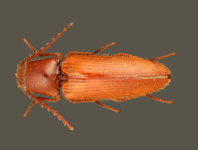Abstract
Holopothrips molzi sp. n. (Thysanoptera: Phlaeothripidae) is described from southern Brazil inducing leaf galls on Myrcia guianensis (Myrtaceae). Field observations revealed that the numbers of this thrips were highly variable within galls, and two other insect species were recorded living in these galls: Myrciathrips variabilis Cavalleri et al. (Phlaeothripidae) and an eulophid wasp (Hymenoptera). We investigated here if morphological traits of leaf and gall and abundance of the invader thrips were correlated with the gall inducer’s abundance. In order to determine the feeding habit and behaviour of M. variabilis and its interactions with the gall inducer we performed observations ad libitum and attack simulation tests on both thrips species to observe their response to possible invaders. Our results showed that leaf size is not related to H. molzi abundance, and gall size is relevant only when total numbers of both thrips species are considered. Myrciathrips variabilis was observed feeding on gall tissues, and no direct antagonistic interactions between the two thrips were recorded. The results of the behavioural tests simulating attacks were remarkably different in the two thrips species, indicating different strategies when threatened or disturbed. The interaction between the two thrips species is probably a case of inquilinism.
References
Ananthakrishnan, T.N. & Raman, A. (1989) Thrips and Gall Dinamics. Oxford & IBH Publishing Co. Pvt. Ltd., New Delhi, 120 pp.
Blum, M.S. (1991) Chemical ecology of the Thysanoptera. In: Parker, B.L., Skinner, M. & Lewis, T. (Eds.), Towards Understanding Thysanoptera. Department of Agriculture, Forest Service, Northeastern Forest Experiment Station, Radnor, pp. 283–291.
Cavalleri, A. & Kaminski, L.A. (2007) A new Holopothrips species (Thysanoptera: Phlaeothripidae) damaging Mollinedia (Monimiaceae) leaves in southern Brazil. Zootaxa, 1625, 61–68.
Cavalleri, A., Lindner, M.F. & Mendonça, M.S. Jr. (2016) New Neotropical Haplothripini (Thysanoptera: Phlaeothripidae) with a key to Central and South American genera. Journal of Natural History, xx, X–X.
http://dx.doi.org/10.1080/00222933.2015.1113316
Cavalleri, A., Souza, A.R., Prezotto, F. & Mound, L.A. (2013) Egg predation within the nests of social wasps: a new genus and species of Phlaeothripidae, and evolutionary consequences of Thysanoptera invasive behaviour. Biological Journal of the Linnean Society, 109, 332–341.
http://dx.doi.org/10.1111/bij.12057
Crespi, B.J., Morris, D.C. & Mound, L.A. (2004) Evolution of ecological and behavioural diversity: Australian Acacia thrips as model organisms. Australian Biological Resources Study & Australian National Insect Collection, CSIRO, Canberra, 328 pp.
Gauthier, N., LaSalle, J., Quicke, D.L.J. & Godfray, H.C.J. (2000) Phylogeny of Eulophidae (Hymenoptera: Chalcidoidea) with a reclassification of Eulophinae and the recognition that Elasmidae are derived eulophids. Systematic Entomology, 25, 521–539.
http://dx.doi.org/10.1046/j.1365-3113.2000.00134.x
Gilbert, J.D.J. (2014) Thrips domiciles protect larvae from desiccation in an arid environment. Behavioral Ecology, 25 (6), 1338–1346.
http://dx.doi.org/10.1093/beheco/aru128
Gilbert, J.D.J., Mound, L.A. & Simpson, S.J. (2012) Biology of a new species of socially parasitic thrips (Thysanoptera: Phlaeothripidae) inside Dunatothrips nests, with evolutionary implications for inquilinism in thrips. Biological Journal of the Linnean Society, 107, 112–122.
http://dx.doi.org/10.1111/j.1095-8312.2012.01928.x
Gopinathan, K. & Ananthakrishnan, T.N. (1986) Morphogenesis and histochemistry of some thrips (Thysanoptera: Insecta) induced galls. Proceedings of the Indian National Science Academy, 51 (B), 513–556.
Hammer, Ø., Harper, D.A.T. & Ryan, P.D. (2001) PAST: Paleontological statistics software package for education and data analysis. Palaeontologia Electronica, 4, 1–9.
Lourenço, A.R.L. & Barbosa, M.R.V. (2012) Myrtaceae em restingas no limite norte de distribuição da Mata Atlântica, Brasil. Rodriguésia, 63, 373–393.
http://dx.doi.org/10.1590/s2175-78602012000200011
Maia, V.C. (2006) Galls of Hemiptera, Lepidoptera and Thysanoptera from Central and South America. Publicações Avulsas do Museu Nacional, 110, 1–24.
Melo, F.S., Cavalleri, A. & Mendonça, M.S. Jr. (2013) Predation of Gynaikothrips uzeli (Thysanoptera: Phlaeothripidae) by Androthrips ramachandrai (Thysanoptera: Phlaeothripidae). Florida Entomologist, 96, 859–863.
http://dx.doi.org/10.1653/024.096.0320
Mound, L.A. (1994) Thrips and gall induction: a search for patterns. In: Williams, M.A.J. (Ed.), Plant Galls: Organisms, Interactions, Populations. Systematics Association Special Volume 49. Clarendon Press, Oxford, pp. 131–149.
Mound, L.A. (2005) Fighting, Flight and Fecundity: Behavioural Determinants of Thysanoptera Structural Diversity, In: Ananthakrishnan, T.N. & Whitman, D. (Eds.), Insects Phenotypic Plasticity. Science Publishers, Inc., Enfield, NH, pp. 81–106.
Mound, L.A. & Marullo, R. (1996) The thrips of Central and South America: an introduction (Insecta: Thysanoptera). Memoirs on Entomology, International, 6, 1–488.
Suzuki, T., Haga, K., Tsutsumi, T. & Matsuyama, S. (2004) Analysis of anal secretions from phlaeothripine thrips. Journal of Chemical Ecology, 30 (2), 409–423.
http://dx.doi.org/10.1023/b:joec.0000017985.89897.c3
ThripsWiki (2016) ThripsWiki—providing information on the World’s thrips. Available from: http://thrips.info/wiki/Main_Page (accessed 15 February 2016)
Toma, T.S.P. & Mendonça, M.S. Jr. (2013) Gall-inducing insects of an Araucaria Forest in southern Brazil. Revista Brasileira de Entomologia, 57 (2), 225–233.
http://dx.doi.org/10.1590/s0085-56262013005000001
Tree, D.J. & Mound, L.A. (2009) Gall-induction by an Australian insect of the family Thripidae (Thysanoptera: Terebrantia). Journal of Natural History, 43, 1147–1158.
http://dx.doi.org/10.1080/00222930902807767
Varadarasan, S.M. & Ananthakrishnan, T.N. (1981) Population Dynamics and Prey-Predator/Parasite relationships of gall-forming thrips. Proceedings of the Indian national Science Academy, 47 (B), 321–340.
Zamora, S., Hanson, P. & Mound, L.A. (2015) Holopothrips chaconi sp. n. (Thysanoptera: Phlaeothripinae) from leaf-vein galls on Piper species (Piperaceae) in Costa Rica. Revista de Biología Tropical, 63 (4), 1035–1042.
http://dx.doi.org/10.15517/rbt.v63i4.16787

